
Dave Wills welcomes you to his rammed earth home
Dave Wills loves to show off his homemade rammed earth home – the first in Benton County. When you see him and ask about it, he’s happy to invite you over to see it and share with you the wonders of this sustainable construction technique and his creative touches.
Dave has been working on his dream home for over eight years – with walls made from the earth from a nearby quarry, a small percentage of Portland Cement, small amounts of color pigments, a special acrylic sealant, and lots of intense labor.

the nearby quarry
Inspired by the church missions built in the 18th century near his hometown in California, Dave said, “If they can last that long, it must be a solid way to build,” explaining why he looked into this atypical method to build his home.
Rammed Earth Construction
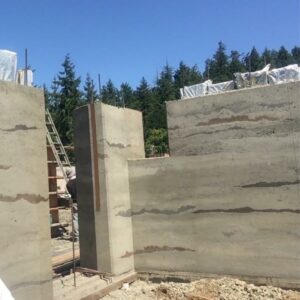
wall construction at the build stage
“I read David Easton’s book Rammed Earth House and then started looking for someone who knows what they’re doing.” Finally, he came across John Richards, who owned Rammed Earth Builders in California. In a phone interview, John said, “I started my company in 1989, and now I only build select projects.” Dave’s home was one of those special projects!
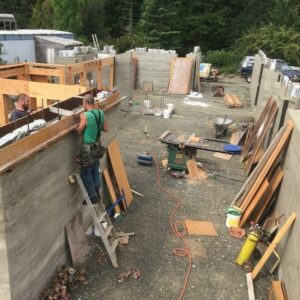
The shiny silver pieces you see at the top of the wall forms are the recycled insulation made of old styrofoam and used mylar bags.
Since the local building department had never dealt with rammed earth before, John and Dave worked with an engineer. They tested the earth and cement mixture, similar to how concrete is tested with PSI (Pounds Per Square Inch). John enjoyed celebrating the completed walls with Dave’s Oregon Trail brews. Although Dave sold his Oregon Trails business in 2020, he now loves to make batches to share with friends.
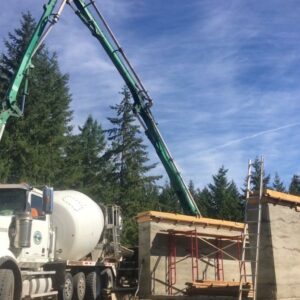
Pouring the cement that lays between the earth and roof
Dave recollected the mixture to have around 7% Portland Cement and the rest aggregate earth from his land and a place down the street. He also explained that cement is used in small amounts to stabilize the soil layers. They then used hydraulic pounders or tampers to ram the earth into the forms that made the walls. Dave said he had about seven people at once working on the walls.
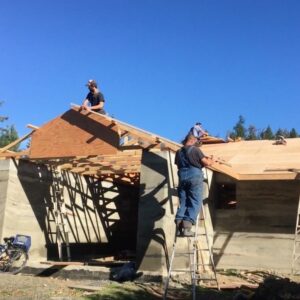
Dave’s friends working on the wood roof
To the left of the front entrance, Dave points out a design in the wall he calls “Mary’s Peak.” Dave says he would mix up five-gallon buckets of earth with pigments and add them as they went along. Then, one day at lunch, they came up with the idea to make the mountain peaks. It was created that afternoon. The way these two-foot thick walls are designed, Dave created the patterns on either side – so you can also see them inside the house.

Mary’s Peak design
Concessions to Oregon Weather

View of the main bedroom from the outside
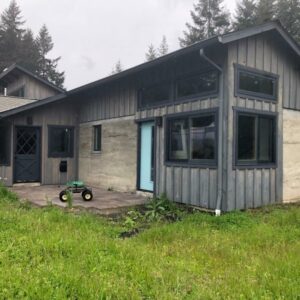
View of the patios, 2nd bedroom, and kitchen
Dave knows that most rammed earth houses are built in warmer climates, like in the Southwest. Unlike wood structures, rammed earth walls have a higher resistance to rot, decomposing, and rain – vital in the rainy Pacific Northwest. In addition, Oregon is also colder, an issue Dave solved in various ways.
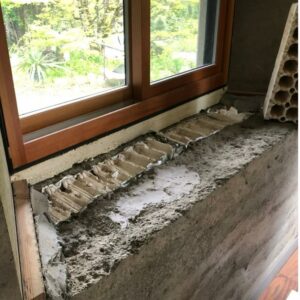
Window sill showing the interior of the insulation and the thickness of the walls
As Dave showed off a window area in the main bedroom that eventually will have a natural wood sill, he pointed out where you can see the insulation placed inside the thick walls.
“From my Freshops business, I have coated mylar bags that can’t be sent to a recycling plant. So I used those for reflective insulation, and stuffed inside are recycled styrofoam planters that capture pockets of air that help with retaining temperatures,” he explained. “This gives my house an R33 insulation factor which is 50% more than the typical home.”

The water heating system – the tubing connects to another heater elsewhere. This heater is for indoor plumbing – instant hot showers are a must!
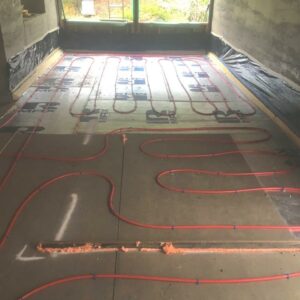
Floor tubing being installed for radiant heat
Another way to stay warm is through heated floors. Dave created a radiant system that runs low-cost, energy-efficient warm water through pipes under the floorboards. “We won’t have to worry about installing any radiators!” exclaims Dave, “and our bare feet won’t be walking on cold floors.”
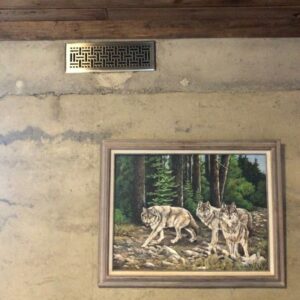
In Dave’s office you can see the rammed earth wall with heat register/return next to a painting of wolves
Dave plans to build a solarium on this side of the home. He already has heat exchanges – seen above the painting of wolves – installed that will take advantage of how heat rises as a further way to warm and cool his home.
Interior Elements of the Rammed Earth Home
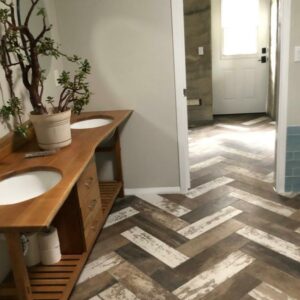
Dave made the bathroom counter and shelves. The floor is made from tile that looks like wood. The door in the back will lead to the solarium.
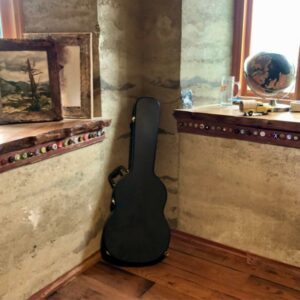
Corner office wall showing bottle caps on window trim and the live edge wood sills.
In the office space, the window ledges are installed and are the same sassafras live wood he plans to use on the unfinished window in the guest bedroom. The beer bottle caps on the trim are a tribute to his beer-related businesses and favorite guessing game, “What is This Mystery Beer?”
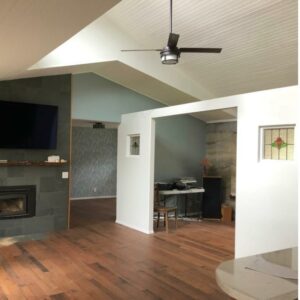
Sunlight is beaming in through the window, over the interior wall to warm up the front rammed earth wall for more passive heating.
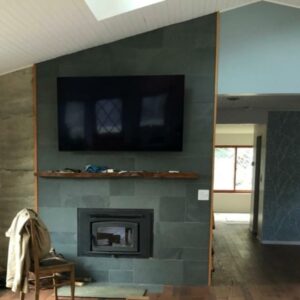
The fireplace has a return so that hot air is forced into the room when wood is burning. Dave also created a special wood holder behind the wall.
Dave has plans for a future side music room off the living room – with the doors installed later – but the walls intentionally don’t reach the ceiling. Instead, Dave designed the roof system with additional south-facing windows so that heat of the sun could reach the opposite walls, keeping that space warmer longer. The fireplace also offers heat exchanges to keep the room toasty on cold winter nights. Interior rammed earth walls also received sealant “to help keep the dust down,” John said.
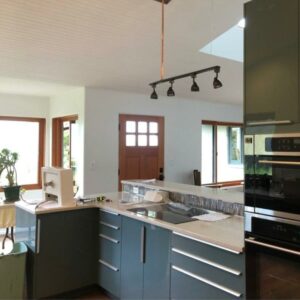
The open plan kitchen was designed at IKEA and has many custom elements.
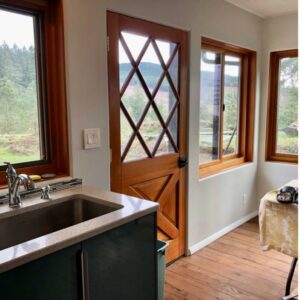
Kitchen view of King’s Valley
The kitchen is part of the open plan concept. The most recent addition was an overhead light made from copper pipes. In addition, Dave is building cement paver patios outside the living room and the other bedroom. He and his wife plan to sit here and enjoy the views of Kings Valley and their Christmas tree farm on warm summer nights.
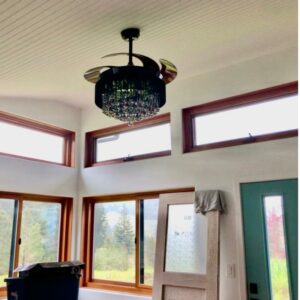
The second bedroom has a chandelier ceiling fan. The waiting-to-be-installed door is from a doctor’s office.
“All the doors except one are from other buildings. The ones for the extra bedroom and bathroom are from old doctor’s offices. I’m making the bathroom vanity from an old dresser and new sink,” bragged Dave. The primary bathroom vanity’s counter and drawers were custom-made with wood from a sassafras tree – the same wood used for window sills around the house.
Fire Prevention

Solar panels by the side of the house, with room on the side for more future rows.

The water tank, high-pressure tank and fire hose
Living on 15 acres of forested land in Philomath, Dave takes measures for fire prevention. He’s participating in a state plan where he trims the trees that border Kings Valley Highway to help prevent the spread of a possible fire. He also has his own fire hose and high-pressure canister attached to his rainwater-filled tank. “I can spray water beyond my solar panels and far all around my house. The rammed earth walls won’t burn, but the wood parts do,” said Dave.
Does Anyone Want the Trailer?
“This house will last hundreds of years,” says Dave. Although he and his wife have slowly moved things over from their mobile home that they’ve lived in for the past 30 years, they won’t fully enjoy the rammed earth house until they can move the mobile home out.
Dave wants to know, “Are you looking for a trailer? I’ve got one to sell!”

Dave Wills, owner of Freshops.com, brewmaster, christmas tree farmer, and builder of his rammed earth home
People interested in learning more can reach Dave through his website at Freshops.com.
Post Script – Dave is my friend and, in the past, taught me how to DIY CBD cream. I first wrote this article for the local paper, which you can find at Corvallis Advocate, “Philomath Man Building Dream Home With Rammed Earth,” but I wanted to provide the unedited, more photos edition here.

 You need more fun & spontaneity in your life, and aren’t sure of next steps or the path to follow. Let’s connect! You could choose a free 15 minute chat, various courses, or even select one-to-one coaching.
You need more fun & spontaneity in your life, and aren’t sure of next steps or the path to follow. Let’s connect! You could choose a free 15 minute chat, various courses, or even select one-to-one coaching.

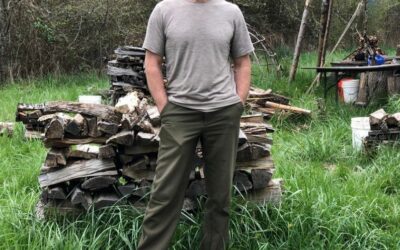

0 Comments